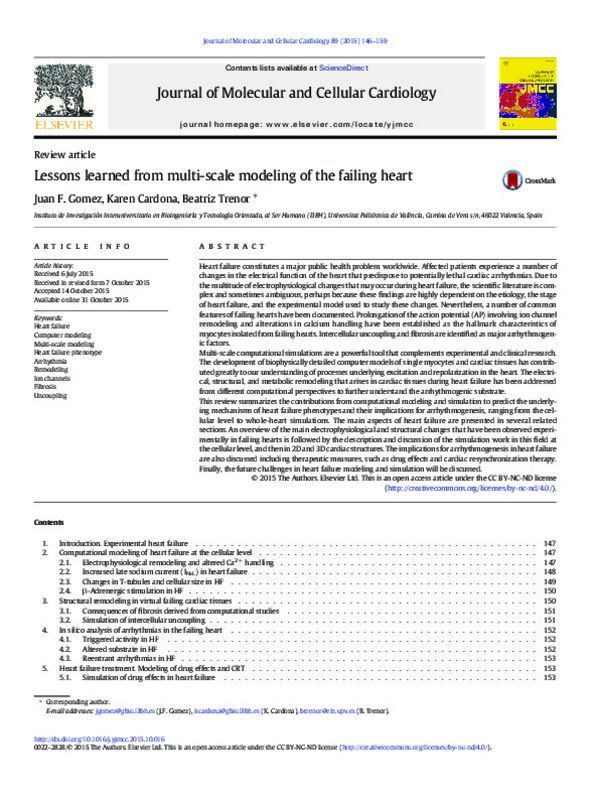JavaScript is disabled for your browser. Some features of this site may not work without it.
Buscar en RiuNet
Listar
Mi cuenta
Estadísticas
Ayuda RiuNet
Admin. UPV
Lessons Learned from Multi-scale Modeling of the Failing Heart
Mostrar el registro sencillo del ítem
Ficheros en el ítem
| dc.contributor.author | Gómez García, Juan Francisco
|
es_ES |
| dc.contributor.author | Cardona-Urrego, Karen Eliana
|
es_ES |
| dc.contributor.author | Trénor Gomis, Beatriz Ana
|
es_ES |
| dc.date.accessioned | 2017-06-28T17:50:32Z | |
| dc.date.available | 2017-06-28T17:50:32Z | |
| dc.date.issued | 2015-12 | |
| dc.identifier.issn | 0022-2828 | |
| dc.identifier.uri | http://hdl.handle.net/10251/83987 | |
| dc.description.abstract | [EN] Heart failure constitutes a major public health problem worldwide. Affected patients experience a number of changes in the electrical function of the heart that predispose to potentially lethal cardiac arrhythmias. Due to the multitude of electrophysiological changes that may occur during heart failure, the scientific literature is complex and sometimes ambiguous, perhaps because these findings are highly dependent on the etiology, the stage of heart failure, and the experimental model used to study these changes. Nevertheless, a number of common features of failing hearts have been documented. Prolongation of the action potential (AP) involving ion channel remodeling and alterations in calcium handling have been established as the hallmark characteristics of myocytes isolated from failing hearts. Intercellular uncoupling and fibrosis are identified as major arrhythmogenic factors. Multi-scale computational simulations are a powerful tool that complements experimental and clinical research. The development of biophysically detailed computer models of single myocytes and cardiac tissues has contributed greatly to our understanding of processes underlying excitation and repolarization in the heart. The electrical, structural, and metabolic remodeling that arises in cardiac tissues during heart failure has been addressed from different computational perspectives to further understand the arrhythmogenic substrate. This review summarizes the contributions from computational modeling and simulation to predict the underlying mechanisms of heart failure phenotypes and their implications for arrhythmogenesis, ranging from the cellular level to whole-heart simulations. The main aspects of heart failure are presented in several related sections. An overview of the main electrophysiological and structural changes that have been observed experimentally in failing hearts is followed by the description and discussion of the simulation work in this field at the cellular level, and then in 2D and 3D cardiac structures. The implications for arrhythmogenesis in heart failure are also discussed including therapeutic measures, such as drug effects and cardiac resynchronization therapy. Finally, the future challenges in heart failure modeling and simulation will be discussed. | es_ES |
| dc.description.sponsorship | This work was partially supported by (i) the "VI Plan Nacional de Investigacion Cientifica, Desarrollo e Innovacion Tecnologica" from the Ministerio de Economia y Competitividad of Spain and the European Commission (European Regional Development Funds ERDF-FEDER) (grant number TIN2012-37546-C03-01), and by (ii) Programa Prometeo de la Conselleria d'Educacio Formacio I Ocupacio, Generalitat Valenciana (grant number PROMETEO/2012/030). | |
| dc.language | Inglés | es_ES |
| dc.publisher | Elsevier | es_ES |
| dc.relation.ispartof | Journal of Molecular and Cellular Cardiology | es_ES |
| dc.rights | Reconocimiento - No comercial - Sin obra derivada (by-nc-nd) | es_ES |
| dc.subject | Heart Failure | es_ES |
| dc.subject | Computer modeling | es_ES |
| dc.subject | Multi-scale modeling | es_ES |
| dc.subject | Heart Failure phenotype | es_ES |
| dc.subject | Arrhythmia | es_ES |
| dc.subject | Remodeling | es_ES |
| dc.subject | Ion channels | es_ES |
| dc.subject | Fibrosis | es_ES |
| dc.subject | Uncoupling | es_ES |
| dc.subject.classification | TECNOLOGIA ELECTRONICA | es_ES |
| dc.title | Lessons Learned from Multi-scale Modeling of the Failing Heart | es_ES |
| dc.type | Artículo | es_ES |
| dc.identifier.doi | 10.1016/j.yjmcc.2015.10.016 | |
| dc.relation.projectID | info:eu-repo/grantAgreement/MINECO//TIN2012-37546-C03-01/ES/CORAZON HUMANO COMPLETO FISIOLOGICO VIRTUAL: MEJORAS EN EL TRATAMIENTO DE ARRITMIAS CARDIACAS ORIENTADO A PACIENTE/ | es_ES |
| dc.relation.projectID | info:eu-repo/grantAgreement/GVA//PROMETEO%2F2012%2F030/ES/MEJORA EN LA PREVENCION Y TRATAMIENTO DE PATOLOGIAS CARDIACAS A TRAVES DE LA MODELIZACION MULTI-ESCALA Y LA SIMULACION COMPUTACIONAL (DIGITAL HEART)/ | es_ES |
| dc.rights.accessRights | Abierto | es_ES |
| dc.contributor.affiliation | Universitat Politècnica de València. Instituto Interuniversitario de Investigación en Bioingeniería y Tecnología Orientada al Ser Humano - Institut Interuniversitari d'Investigació en Bioenginyeria i Tecnologia Orientada a l'Ésser Humà | es_ES |
| dc.contributor.affiliation | Universitat Politècnica de València. Departamento de Ingeniería Electrónica - Departament d'Enginyeria Electrònica | es_ES |
| dc.description.bibliographicCitation | Gómez García, JF.; Cardona-Urrego, KE.; Trénor Gomis, BA. (2015). Lessons Learned from Multi-scale Modeling of the Failing Heart. Journal of Molecular and Cellular Cardiology. 89:146-159. https://doi.org/10.1016/j.yjmcc.2015.10.016 | es_ES |
| dc.description.accrualMethod | S | es_ES |
| dc.relation.publisherversion | http://dx.doi.org/10.1016/j.yjmcc.2015.10.016 | es_ES |
| dc.description.upvformatpinicio | 146 | es_ES |
| dc.description.upvformatpfin | 159 | es_ES |
| dc.type.version | info:eu-repo/semantics/publishedVersion | es_ES |
| dc.description.volume | 89 | es_ES |
| dc.relation.senia | 294390 | es_ES |
| dc.identifier.pmid | 26476237 | |
| dc.contributor.funder | Ministerio de Economía y Competitividad | |
| dc.contributor.funder | Generalitat Valenciana |








